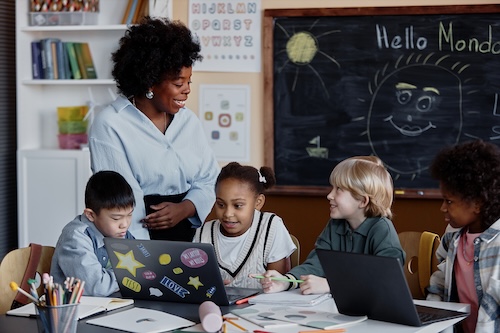Key points:
For nearly two decades, I’ve worked to improve teaching and learning with technology. And while the continuously evolving nature of technology has changed the trajectory of my career many times, I have always tried to drive deeper student engagement.
Education stakeholders agree on the importance of engagement in learning. According to the recently released Education Insights Report, K-12 leaders, teachers, parents, and students overwhelmingly agree that engagement drives learning. To be more specific, 93 percent of educators say it’s a critical metric for achievement, 99 percent of superintendents rank it among the top predictors of school success, and 92 percent of students report that engaging lessons make school more enjoyable.
During my career, I’ve found that one of the best ways to engage students in learning is to connect what is being taught to students in the classroom to potential career paths. One way to connect the dots between classroom lessons and their application to a potential career is through career-connected learning.
Career-connected learning (CCL) experiences–such as classroom career lessons, job fairs, and mentorships–have a measurable impact on student engagement and future orientation. A recent report found that 88 percent of students participate in at least one CCL opportunity, and that having a mentor nearly doubles student engagement (37 percent vs. 16 percent), while also increasing students’ hope about their future (40 percent vs. 25 percent).
Educational technology can help educators scale CCL learning in their district. At my school, I’ve found success with Career Connect, which can be accessed through Discovery Education Experience. This technology solution is an innovative, virtual platform that facilitates direct, real-time connections between K-12 educators, students, and industry professionals. Key features include on-demand, virtual classroom visits and an easy-to-navigate dashboard with accompanying standards-aligned lesson plans and activities.
Career Connect has allowed instructional specialists and professional development consultants in our field to assist CTE teachers with additional credible and trusted resources. This enables our educators to create meaningful connections and higher engagement by embedding real-world voices to help students see the “why” behind learning, which sparks curiosity and motivation. Plus, the solution helps ensure equitable access for all students, because the virtual format allows schools anywhere to bring a broad range of professionals from all the over the world directly into their classrooms.
Another favorite tool is CareerPrepped, a free resource by the Association for Career and Technical Education. Designed to meet the needs of learners, educators, and employers, the platform supports skills-based hiring, soft-skills development, and work-based learning through a dynamic digital platform.
With over 40 essential workforce skills, students can build Skill Builders across competencies like teamwork, communication, problem-solving, time management, and more. These skills are demonstrated through Skill Badges and a career portfolio that houses real-world evidence such as project artifacts and multimedia illustrations. Students can create a personal portfolio that connect to platforms like LinkedIn. Then, students can request feedback on their skill evidence from peers, educators, and industry mentors, helping them understand strengths and areas for improvement.
CareerPrepped offers value for educators by bridging the gap between academic learning and employability while enhancing work-based learning outcomes. Students actively document and prove their skills to employers and class alike.
Implementing career-focused technology tools such as Career Connect and CareerPrepped in education offers many ways to integrate CCL into the classroom. Here are some potential strategies to consider:
- Employee Spotlights: Host brief live or recorded talks with people in various careers to hear about job journeys and directly tie in a classroom lesson to that career. Bonus points if that employee is a former student of that district!
- Micro-Internships: Arrange one-hour or one-day job shadows with local partners.
- Challenge-Based Projects: Partner with businesses on real problems, like designing a locally-sourced cafeteria menu or revamping a playground.
In summary, career-connected learning is a vital component of any classroom in this day and age, because it brings together traditional learning with real-world opportunities. By engaging students with industry partners, mentors, and authentic workplace experiences, students are empowered to see clear pathways from education to career success.
These connections not only strengthen technical and employability skills but also foster confidence and purpose for each student. Ultimately, career connections ensure that all students graduate prepared, inspired, and equipped to thrive in both postsecondary education and the workforce.
This post is exclusively published on eduexpertisehub.com
Source link

